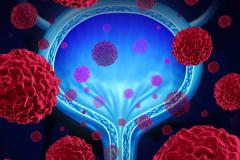
Factors in Selecting Frontline Therapy for Advanced Bladder Cancer
Centering focus on the first-line treatment armamentarium, key opinion leaders consider factors that aid in the selection of best therapy for patients with advanced bladder cancer.
Episodes in this series

Transcript:
Petros Grivas, MD, PhD: Let me jump through a bit more of our case here. This patient definitely gets a urology consult, this is necessary, as we discussed. The cystoscopy showed the tumor in the right lateral bladder wall very close to the right ureter, the ureterovesical bladder junction [UVJ]. The tissue acquisition, the TURBT [transurethral resection of bladder tumor], showed pathology with high-grade muscle-invasive urothelial carcinoma. And the imaging studies showed obstruction of the right ureter with hydronephrosis on the right side, and also a couple of perivesical lymph nodes that looked highly suspicious for metastatic disease. So the clinical stage is T3 and T2, based on the suspicion of extravesical disease, the hydronephrosis on the right side, and the couple of enlarged lymph nodes that anatomically, by appearance and size, look like bladder cancer. Because of all these challenges, this patient has an ECOG performance status of 2. The kidney function may be impacted by the hydronephrosis as well, the GFR [glomerular filtration rate] estimation is 45 mL/min, and the patient also has grade 2 hearing loss.
In many of those cases, Emily, we discussed a nephrostomy tube or a stent, and I think that’s relevant, especially if we think of cisplatin as a potential chemotherapy option. We had a tumor board yesterday with Dr Weg, and we had 3 patients for whom we discussed this scenario. Emily, I know when we have localized disease vs metastatic disease, the treatment intent is different, it’s curative vs palliative. [Do you have] any comments on your part about a nephrostomy tube maybe preferred in localized disease to avoid spreading to the upper tract? But for a patient with metastatic disease, maybe a stent if it’s feasible?
Emily S. Weg, MD: I think a nephrostomy tube is generally preferable when we’re dealing with localized disease. That’s based on some early data that stents may promote the spread of cancer up along the urinary tract, and you could develop an upper tract recurrence at some later time point. I think, ironically with 3 of our patients in our multidisciplinary cancer clinic yesterday, one factor we take into account is, if patients have a TURBT of disease that was along the lateral bladder wall at the UVJ or the UO, there is some concern for the development of scar tissue at the UVJ or in the distal ureter that could promote stricture down the road. And especially if we’re thinking about moving in the direction of radiation, it might be prudent to leave a stent in place, especially if they’re going to go back for a second TUR [transurethral resection], to prevent or minimize the risk of developing strictures, before exposing the patient to radiation, which we know can also promote scar tissue.
Petros Grivas, MD, PhD: Excellent point, very good point. Lisa, in your practice do you often use nephrostomy tubes or stents in those patients to optimize kidney function? Of course, again, it depends on the treatment setting and intent.
Lisa Adams, PA-C: Correct. Depending on what the goal of care is and what upfront therapy plan may be recommended, we do try to improve kidney function and prefer nephrostomy tubes also. Again, going back to that multidisciplinary discussion with our team to figure out how to best accomplish that is always important.
Petros Grivas, MD, PhD: Absolutely. It’s as you said, a multidisciplinary approach. Nerina, we see those patients in the clinic all the time, and we try to make a decision about whether that patient is eligible or fit for cisplatin up front in the induction chemotherapy setting. If yes, we usually tend to use GemCis [gemcitabine and cisplatin]. If not, we may use GemCarbo [gemcitabine and carboplatin] or other regimens. [Do you have] any comments about the criteria we use in the clinic to define or estimate how fit the patient is to get cisplatin?
Nerina T. McDonald, PA-C: Typically, we’re looking at the Galsky criteria, which are broken down into a few parts. Typically, we would want patients to have an ECOG performance status of less than or equal to 2, and creatinine clearance that is greater than or equal to 60 mL/min. That’s sort of a gray area that we’ll discuss further. Grade 2 or higher hearing loss usually negates cisplatin eligibility, and the same with grade 2 or higher neuropathy. The New York Heart Association class 3 heart failure or beyond would also preclude a patient from being eligible for cisplatin.
Petros Grivas, MD, PhD: This is one of those moments in practice that won a consensus, led by [Matthew] Galsky, [MD,] and was published in JCO [Journal of Clinical Oncology] in 2011, and has defined more than a decade of practice. And this, to your point, has had some gray areas and some variability. You already mentioned kidney function, maybe different people have different thresholds to give cisplatin. With the hearing loss, it may require a bit of discussion with the patient, how much they’re worried about it, do they have hearing aids, is it treatment curative intent or palliative intent? Lisa, any comments on your practice and how you deal with those gray areas of cisplatin eligibility?
Lisa Adams, PA-C: It’s definitely a discussion of the pros and cons with the patient as well, and maybe considering other factors. Sometimes we have patients who are very manually active with their hands, musicians. Maybe neuropathy would be a larger concern for certain subsets of patients, and they may not be as willing to accept that risk with cisplatin. And thinking about disease biology, is that affecting the current kidney function? Do we have a chance to improve that and recover kidney function? That can definitely be an opportunity, especially in curative intent settings, where we may prefer to use cisplatin a bit more aggressively and maybe we’re going to recover that kidney function. So, it’s definitely a lot of nuance for each patient scenario.
Petros Grivas, MD, PhD: Absolutely. It’s individualized and it’s always important to take the patient preference into account as well. The other thing that has come forward recently, which I would never imagine, is a cisplatin and carboplatin shortage. I was shocked, I was called to a literacy meeting a few weeks ago with a chief medical officer and other clinical directors, and we said, “Guys, we have a problem. We do not have enough [carboplatin] or [cisplatin] for our patients down the road.” Lisa, did that impact your practice too? I’m sure it’s a problem for the majority of practices in the United States.
Lisa Adams, PA-C: Definitely. We did experience a carboplatin shortage for several weeks in mid-May, and that did lead to some difficult decisions. We in our practice decided to reserve our available carboplatin for patients being treated in curative intent settings. Then for patients who were on palliative therapies, we looked at if cisplatin would be an appropriate short-term substitution depending on the patient scenario, or could we change therapies, or for a short time do a deintensified therapy, depending on the patient status and goals of care where they were in their treatment. But it definitely led to some hard decisions, and we had to work with our pharmacy staff and help decide how best to manage our resources.
Petros Grivas, MD, PhD: Absolutely. It’s a very challenging situation, and I know everybody’s looking at it. It’s a manufacturing issue, and it applies even to BCG [Bacillus Calmette-Guerin] in urology practices and other chemotherapy drugs. It’s definitely relevant in practice.
Transcript edited for clarity.
Newsletter
Stay up to date on recent advances in the multidisciplinary approach to cancer.








